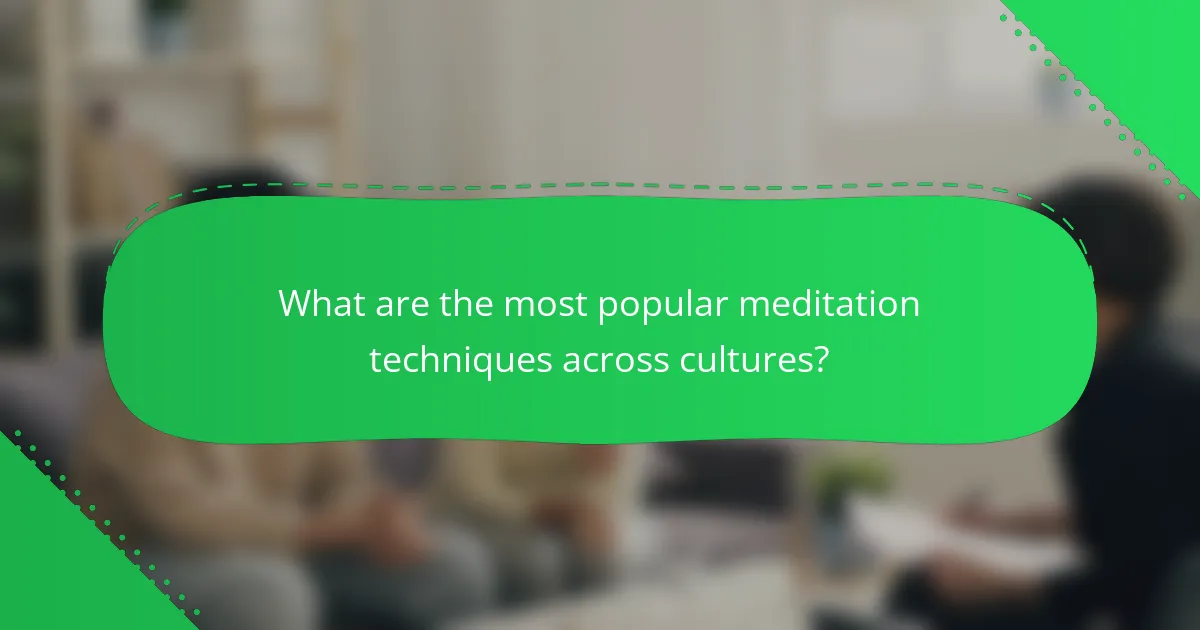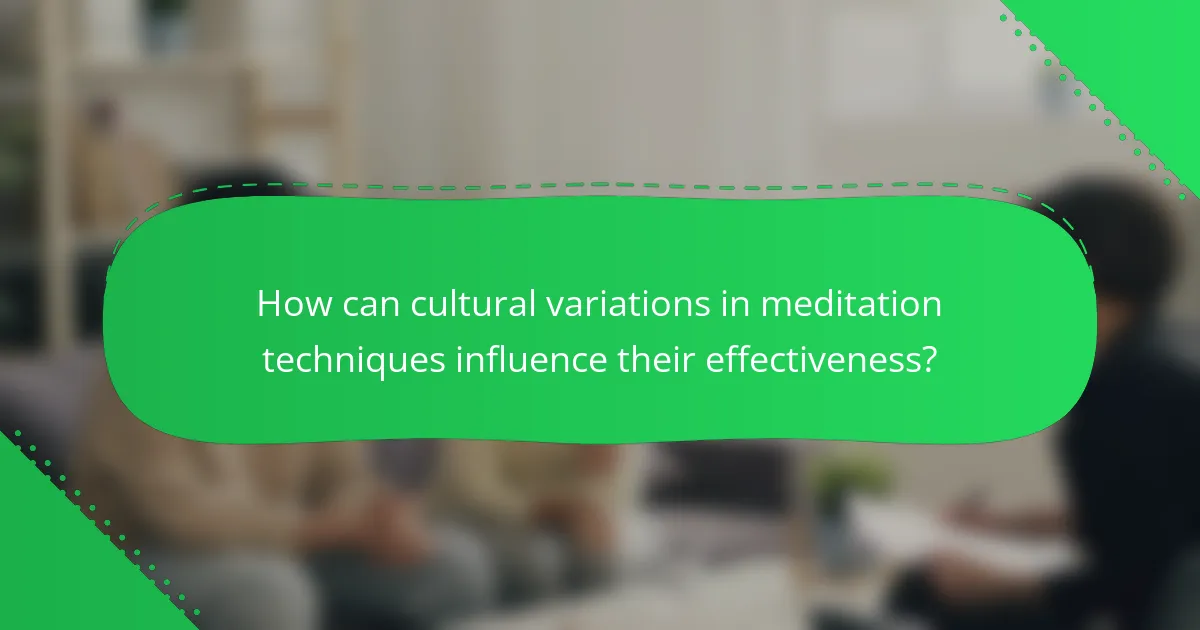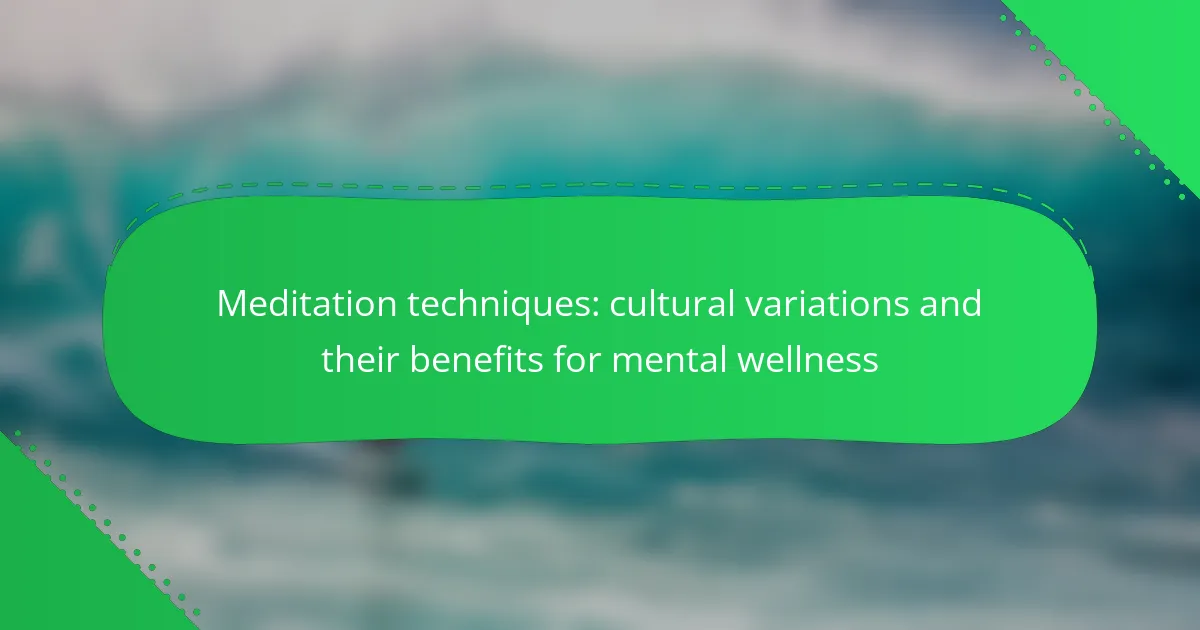Meditation techniques offer significant benefits for mental wellness, including stress reduction and improved focus. Various cultures practice distinct methods, such as mindfulness, transcendental, Zen, and loving-kindness meditation. Each technique emphasizes unique approaches that enhance emotional regulation and mental clarity. Understanding these cultural variations can optimize meditation’s effectiveness for individual mental health needs.

What are the most popular meditation techniques across cultures?
Various cultures practice distinct meditation techniques, each offering unique benefits for mental wellness. Popular techniques include mindfulness meditation, transcendental meditation, Zen meditation, and loving-kindness meditation.
Mindfulness meditation, rooted in Buddhist traditions, enhances present-moment awareness and reduces stress. Transcendental meditation, originating from India, promotes deep relaxation and increases creativity. Zen meditation, practiced in Japan, emphasizes thought observation and promotes mental clarity. Loving-kindness meditation, found in various cultures, fosters compassion and emotional resilience.
These techniques contribute to improved mental health by reducing anxiety, enhancing focus, and promoting emotional stability.
How do mindfulness practices differ in Eastern and Western traditions?
Mindfulness practices in Eastern and Western traditions differ significantly in approach and techniques. Eastern traditions often emphasize meditation as a path to enlightenment, focusing on techniques like Zen and Vipassana. These practices cultivate deep awareness and acceptance, promoting mental clarity and emotional stability. Conversely, Western traditions frequently integrate mindfulness into therapeutic practices, such as cognitive behavioral therapy. Techniques like guided imagery and breath-focused exercises aim to reduce stress and enhance well-being. Both traditions offer unique benefits, with Eastern practices fostering a profound sense of inner peace and Western methods emphasizing practical applications for daily life.
Which meditation styles are prevalent in Japan and their cultural significance?
Zen meditation and Shikantaza are prevalent in Japan, reflecting deep cultural significance. Zen emphasizes mindfulness and presence, fostering mental clarity. Shikantaza, or “just sitting,” promotes non-attachment, enhancing emotional resilience. These practices contribute to Japan’s cultural identity, emphasizing harmony and introspection. Their benefits for mental wellness include reduced stress and improved focus, aligning with traditional values of simplicity and balance.
What unique attributes define Tibetan meditation practices?
Tibetan meditation practices are defined by unique attributes such as visualization techniques, integration of mantras, and the emphasis on compassion. These practices often involve the use of specific postures and breathing techniques that enhance mental clarity. Additionally, Tibetan meditation incorporates elements of Tibetan Buddhism, focusing on the interconnectedness of all beings. This cultural context enriches the meditation experience, promoting both individual and collective well-being.
How has the perception of meditation evolved in Russian culture?
The perception of meditation in Russian culture has shifted from skepticism to acceptance and integration into wellness practices. Initially viewed as a foreign concept, meditation is now recognized for its mental wellness benefits.
Historically, Russian society associated meditation with Eastern philosophies, often perceiving it as incompatible with traditional values. However, recent years have seen an increase in interest, particularly among urban populations. This change is influenced by growing awareness of mental health and stress management.
Contemporary Russian meditation practices often blend traditional techniques with modern psychological approaches. Popular forms include mindfulness meditation and guided imagery, appealing to those seeking stress relief and emotional balance.
Research indicates that regular meditation can enhance cognitive function and emotional regulation, contributing to overall mental wellness. As a result, meditation is increasingly embraced in various settings, including schools and workplaces, reflecting a broader cultural acceptance.

What benefits do meditation techniques offer for mental wellness?
Meditation techniques offer various benefits for mental wellness, including stress reduction, improved focus, and enhanced emotional regulation. Different cultural practices, such as mindfulness from Buddhism and transcendental meditation from Hinduism, emphasize unique approaches that foster mental clarity and resilience. Research shows that regular meditation can decrease anxiety levels by up to 60% and increase overall life satisfaction. Additionally, unique attributes of specific techniques, like loving-kindness meditation, promote compassion and empathy, enriching interpersonal relationships.
How does meditation impact stress reduction and emotional health?
Meditation significantly reduces stress and enhances emotional health. Various techniques, like mindfulness and transcendental meditation, promote relaxation and emotional regulation. Cultural variations in practice provide diverse benefits, such as improved focus and resilience. Research indicates that regular meditation can lower cortisol levels, contributing to overall mental wellness.
Which meditation practices enhance cognitive function and concentration?
Meditation practices that enhance cognitive function and concentration include mindfulness meditation, transcendental meditation, and focused attention meditation. Mindfulness meditation improves awareness and attention, while transcendental meditation reduces stress, promoting better focus. Focused attention meditation trains the brain to concentrate on a single object, enhancing cognitive skills. These techniques vary culturally, yet their benefits for mental wellness are universally recognized.
What role does meditation play in promoting resilience and emotional regulation?
Meditation enhances resilience and emotional regulation by fostering mindfulness and self-awareness. Techniques like mindfulness meditation and loving-kindness meditation cultivate emotional balance and stress reduction. Research indicates that consistent practice leads to improved emotional responses and better coping mechanisms. Cultural variations in meditation, such as Zen or Transcendental Meditation, offer diverse approaches, yet all share the core benefit of promoting mental wellness.

How can cultural variations in meditation techniques influence their effectiveness?
Cultural variations in meditation techniques significantly influence their effectiveness by tailoring practices to specific mental wellness needs. Different cultures emphasize unique attributes, such as mindfulness in Buddhism or transcendental techniques in Hinduism. These cultural roots shape the approach and outcomes of meditation. For instance, research shows that mindfulness practices can enhance emotional regulation, while mantra-based techniques may improve focus. The integration of cultural context into meditation can lead to enhanced benefits, making it essential to consider these variations for optimal mental health outcomes.
What factors contribute to the success of meditation practices in different societies?
Cultural factors significantly influence the success of meditation practices. These include historical context, social acceptance, and integration into daily life. For example, in Eastern societies, meditation often has deep religious roots, enhancing its acceptance and practice. In contrast, Western societies may focus on mindfulness for stress relief, emphasizing mental wellness benefits. Unique attributes, such as community support in group practices, also contribute to effectiveness. Additionally, access to resources and trained instructors can vary, impacting the overall success of meditation techniques across cultures.
How do personal beliefs and cultural backgrounds shape meditation experiences?
Personal beliefs and cultural backgrounds significantly influence meditation experiences by shaping techniques and perceptions. Different cultures integrate unique practices that reflect their values and philosophies. For example, mindfulness meditation, rooted in Buddhist traditions, emphasizes present-moment awareness, while transcendental meditation focuses on mantra repetition. These variations can enhance mental wellness by addressing specific cultural needs and beliefs, creating a deeper connection to the practice. Cultural context also affects how individuals perceive stress relief and emotional balance, demonstrating the importance of personalized approaches to meditation for optimal benefits.
What are the challenges faced when adapting meditation techniques across cultures?
Adapting meditation techniques across cultures presents challenges such as differing cultural beliefs, language barriers, and varying levels of acceptance. Cultural context influences how meditation is perceived and practiced. For instance, some cultures may view meditation as a spiritual practice, while others see it as a wellness tool. This divergence can create misunderstandings about the techniques’ purpose and benefits. Additionally, language differences can hinder effective communication of meditation principles, making it difficult to convey nuances. Lastly, the integration of meditation into diverse lifestyles may face resistance due to existing mental health paradigms, which can limit its adoption and effectiveness.

Which meditation techniques are considered rare or unique in specific cultures?
Certain meditation techniques are unique or rare in specific cultures, offering distinct benefits for mental wellness. For instance, the practice of “Zazen” in Zen Buddhism emphasizes seated meditation, enhancing mindfulness and presence. Similarly, “Trataka,” a form of candle gazing from Indian traditions, sharpens concentration and mental clarity. The “Sufi whirling” technique involves spinning to achieve a trance state, promoting emotional release and spiritual connection. Each of these practices showcases unique attributes that contribute to mental wellness in culturally specific ways.
What are the distinctive features of indigenous meditation practices?
Indigenous meditation practices feature unique techniques that reflect cultural heritage and promote mental wellness. These practices often emphasize connection to nature, community, and spiritual beliefs. For example, Native American meditation may incorporate drumming and chanting, enhancing emotional release and communal bonding. Similarly, Buddhist meditation focuses on mindfulness and compassion, fostering inner peace and resilience. These cultural variations provide diverse benefits such as stress reduction, emotional regulation, and enhanced self-awareness, making them valuable for mental health.
How do ceremonial and ritualistic elements enhance meditation in various cultures?
Ceremonial and ritualistic elements significantly enhance meditation by fostering a deeper connection to cultural traditions. These elements often include specific practices, symbols, and settings that create a conducive atmosphere for mindfulness. For example, in Tibetan Buddhism, the use of prayer flags and mantras enriches the meditative experience, promoting mental clarity and emotional balance. Similarly, Native American ceremonies often incorporate drumming and singing, which can elevate spiritual awareness and community bonding. Such practices highlight the unique attributes of meditation across cultures, emphasizing its role in mental wellness.
What lesser-known meditation techniques are gaining popularity globally?
Lesser-known meditation techniques gaining popularity include sound meditation, forest bathing, and movement-based practices. These techniques offer unique benefits for mental wellness, such as enhanced focus and emotional balance. Sound meditation uses auditory stimuli to induce relaxation, while forest bathing promotes mindfulness through nature immersion. Movement-based practices, like yoga and tai chi, integrate physical activity with meditation, improving both mental and physical health.

What practical tips can enhance the effectiveness of meditation practices?
Practicing meditation effectively can be enhanced through various practical tips. Establish a consistent schedule to create a routine. Choose a comfortable and quiet space to minimize distractions. Experiment with different techniques, such as mindfulness or loving-kindness meditation, to find what resonates. Incorporate guided sessions or apps for structure and support. Use breath awareness to anchor your practice and deepen focus. Finally, approach meditation with patience, recognizing that progress takes time.
How can individuals tailor meditation techniques to their personal needs?
Individuals can tailor meditation techniques by identifying their specific needs and preferences. Personalizing meditation enhances its effectiveness for mental wellness.
For example, those seeking stress relief might prefer mindfulness meditation, while individuals aiming for emotional healing may benefit from loving-kindness meditation. Cultural variations in techniques, such as Zen or Transcendental meditation, offer diverse approaches to meet different mental health goals.
Experimenting with duration and frequency also allows individuals to find what fits their lifestyle. Some may thrive on daily short sessions, while others may prefer longer, less frequent practices.
Incorporating personal values and beliefs can deepen the meditation experience. This unique attribute fosters a more meaningful connection to the practice, enhancing overall mental wellness.
What common mistakes should be avoided when starting a meditation practice?
Common mistakes to avoid when starting a meditation practice include unrealistic expectations, neglecting consistency, and focusing too much on the outcome. Many beginners expect immediate results, which can lead to frustration. Practicing meditation sporadically diminishes its benefits; establishing a routine is essential for mental wellness. Additionally, fixating on achieving a specific state can hinder the experience. Embrace the process, allowing for personal growth and exploration of various cultural meditation techniques, each offering unique benefits.
Which resources can support individuals in exploring diverse meditation techniques?
Various resources can help individuals explore diverse meditation techniques. Online platforms like apps and websites offer guided sessions, while community centers provide in-person classes. Books and podcasts delve into cultural variations and benefits. Social media groups foster discussion and shared experiences. Research articles provide insights into effectiveness and mental wellness. Local workshops connect practitioners and experts for hands-on learning.
